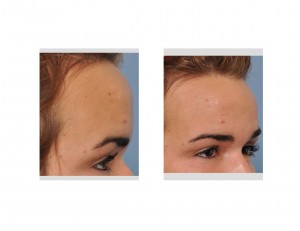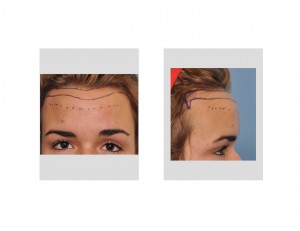
The most pleasing amount of forehead show varies amongst women, but the ideal female hairline is usually no more than 6 cms. from the upper edge of the eyebrows. This is usually where the transition occurs into the vertical slope of the forehead. When the hairline is too high, it is displaced behind this transition zone into the more horizontal slope of the forehead. This is a masculinizing look. Some women are able to hide their high forehead with bangs but other women’s hair qualities may not permit such camouflage.
The high female hairline becomes particularly problematic when most forms of a browlift are being considered, particularly the endoscopic browlift. In this type of browlift, the frontal hairline moves backward as the brows move up due to an overall backward epicranial tissue movement. Because of the scalp location of the upward pull, the hairline actually moves back further than the amount the brows are lifted. This makes an endoscopic browlift in a patient with a long forehead aesthetically disadvantageous.

The forehead reduction is performed through an incision just inside the fine hairs of the frontal anterior hairline. But putting the incision there, hairs will grow through the scar and help hide it better.Once the incision is made, the skin and forehead tissues are raised down to the bone level a few centimeters to where the projected amount of forehead skin is to be removed. If a browlift is being simultaneously done, then the forehead tissues is lifteddown to the brow bones. Behind the hairline, the entire scalp is freed up all the way back to the back of the head. This adds significantly to any scalp looseness and is necessary in every patient. The scalp is then brought forward and overlapped on top of the forehead skin. The typical amount of advancement obtained is usually around 1.5 to 2 cms. Occasionally it may be as much as 2.5 cms. The edge of the scalp advancement is marked on the forehead skin to safely determine how much can be removed. The measured amount of forehead skin is then removed.
As part of forehead shortening, frontal bone bossing can also be reduced. The bulging outer forehead bone, which is just in front of the high hairline, can be shaved down at least 3 or 4mms. A lower frontal hairline with some upper forehead bone flattening can make a big difference in the appearance of the upper forehead.
One of the key elements of hairline lowering is bone fixation of the scalp and forehead flaps at the time of closure. The forehead skin must not be lifted up and the scalp flap containing the hairline must not be pulled backwards. This requires absolute stability at the union of these two tissue edges. I prefer suture fixation to the bone through angled holes made in the outer cortex of the skull. The galea (deeper layer under the skin) of both the scalp and forehead are sutured down to the bone. The skin is closed independent of these bone fixation sutures and results in a tension-free closure.

Advancement of the female hairline and shortening of a high forehead is extremely effective, has few complications, and has a quick recovery. Although there is a resultant hairline scar, it usually heals well and is worth the trade-off for the amount of forehead length reduction.
Dr. Barry Eppley
Indianapolis, Indiana


